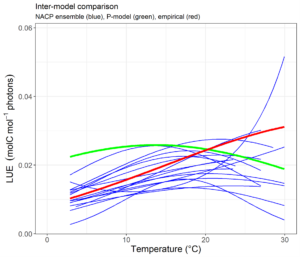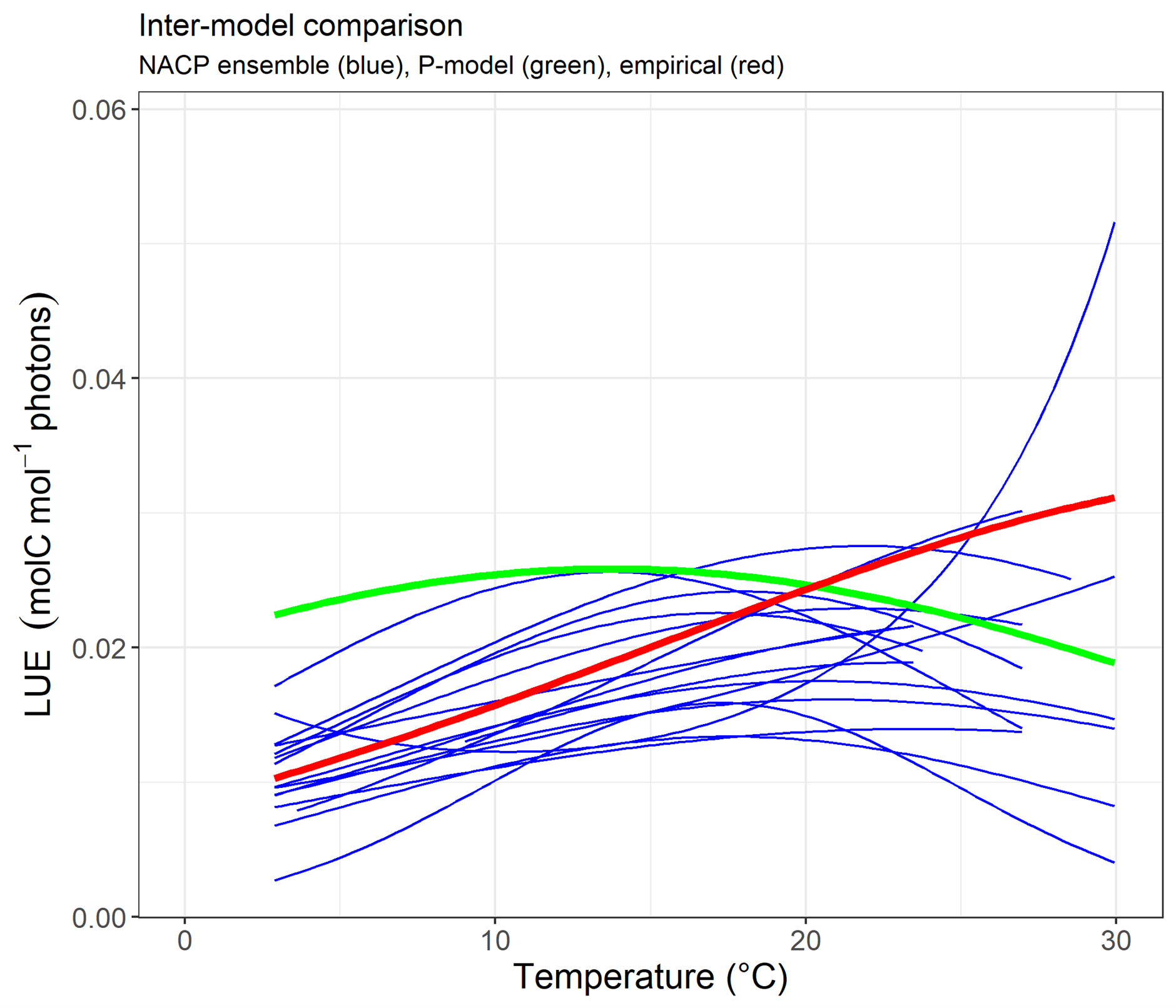By Dr Keith Bloomfield
A general formula for photosynthesis is enticingly simple: take a green plant, add carbon dioxide, water, a handful of nutrients (dominated by forms of nitrogen and phosphorus) and sunlight. The plant will generate carbohydrates and oxygen thereby sustaining global food webs and the air we breathe.
Of course, the process is not so simple and much remains to be learned about the linked reactions, cycles and feedbacks. But the critical drivers for the reactions can be postulated and should allow us to advance a model that simulates levels of plant productivity. Like most chemical processes, carbon assimilation is influenced by temperature – so we need to add that to the mix.
Gross primary production (GPP) by terrestrial ecosystems is a key quantity in the global carbon cycle. This is the domain of the land surface model (LSM) that attempts to simulate the coupled fluxes of carbon, water and energy between the land and the atmosphere. The earliest LSMs date from the 1970s and as the models proliferate in number, they also grow in complexity as additional processes are included, but with no consistent trend towards better performance or consensus in design.
Many (perhaps most) LSMs operate by dividing the land surface into vegetation-dependent tiles; these vegetation classes are often referred to as Plant Functional Types (PFT). PFT-specific trait values are then required to drive the global LSM. But there are hundreds of thousands of species of vascular plants and we can never hope to measure all plants, everywhere, in all seasons. Could a single predictive model work for all species in all locations? That is the ultimate ambition of the Productivity model (P-model, Wang et al., 2017) under development within Lab Prentice and much examined on these pages. Ideally, such a model would be based on available theory, rather than reliant on empirical observations, and would be driven by publicly available, remotely sensed data – removing (or greatly reducing) the need for expensive and laborious field campaigns.
The instantaneous controls of leaf-level photosynthesis are well established, but there is still no consensus on the mechanisms by which canopy-level GPP depends on spatial and temporal variation in the environment. The standard model of photosynthesis (Farquhar et al., 1980) provides a robust mechanistic representation for C3 species, however, additional assumptions are required to ‘scale up’ from leaf to canopy. As a consequence, competing models make inconsistent predictions about how GPP will respond to continuing environmental change.
This problem is addressed in our recent paper in Global Change Biology. This paper by means of an empirical analysis of the light use efficiency (LUE) of GPP inferred from eddy-covariance carbon dioxide flux measurements, in situ measurements of photosynthetically active radiation (PAR) and remotely sensed estimates of the fraction of PAR (fAPAR) absorbed by the vegetation canopy. Focusing on LUE allows potential drivers of GPP to be separated from its overriding dependence on light. GPP data from over 100 sites, collated over 20 years and located in a range of biomes and climate zones, were extracted from the FLUXNET2015 database and combined with remotely sensed fAPAR data to estimate daily LUE. Daytime air temperature, vapour pressure deficit, diffuse fraction of solar radiation and soil moisture were shown to be salient predictors of LUE. The same model design was fitted to site-based LUE estimates generated by 16 terrestrial ecosystem models forming part of the North American Carbon Program (NACP, Schaefer et al., 2012).
The published models showed wide variation in the shape, the strength and even the sign of the environmental effects on modelled LUE. These findings highlight important model deficiencies and suggest a need to progress beyond simple ‘goodness of fit’ comparisons of inferred and predicted carbon fluxes towards an approach focused on the functional responses of the underlying dependencies.

Figure 1. A common dataset of environmental variables, including temperature and measures of air and soil moisture, produced widely differing effects when applied to productivity predictions generated by an ensemble of terrestrial biosphere models. The published models showed variation in the shape, the strength and even the sign of the environmental effects on modelled light use efficiency (mol C mol-1 photons). ©Keith Bloomfield.
At present, we do not model the effects of temperature particularly well. This is evident when comparing the functional responses in the figure above: contrast the relationship predicted by the best-fitting empirical model applied to the dataset (in red) and that corresponding to the P-model (in green). The P-model requires far fewer parameters than most current terrestrial models, but it is under continuous development and one challenge now is how to introduce a more realistic temperature response. The process of acclimation, whereby plants’ temperature maxima might be shifted in response to changing conditions, is an important and highly topical consideration. Differential canopy penetration by diffuse and direct radiation, a phenomenon ignored by ‘big leaf’ models, is another essential line of development.
Concurrent work (not shown here) has highlighted a third area for potential improvements. The P model correctly predicts the observed temperature dependence of the ratio of electron transport capacity (Jmax) to carboxylation capacity (Vcmax). It also correctly predicts that this ratio increases with enhanced CO2 (eCO2); however, experimental evidence indicates that the simulated increase is much too large, leading to modelled Jmax increasing with eCO2 while observed Jmax generally decreases (along with Vcmax). These last two issues are probably linked, and have required us to re-examine the optimality criterion applied to Jmax.
The analysis published here suggests it is feasible to predict GPP using a single model structure, common across vegetation categories. The need for a better understanding of the key drivers is echoed in a recent paper by He et al (2022) arguing in part for a move away from reliance on PFT-averaged coefficients to climate-environment relationships. But the goal of a model design that is at once simple, theoretically well-founded and robust continues to generate scientific challenges.
You can read the full paper here:
Bloomfield, K.J., Stocker, B.D., Keenan, T.F. and Prentice, I.C. 2022. Environmental controls on the light use efficiency of terrestrial gross primary production. Global Change Biology, doi.org/10.1111/gcb.16511
Dr Keith Bloomfield
Keith is a member of the LabPrentice REALM Team at Imperial College London. He is interested in plant eco-physiology and the genetic and environmental sources of variation in leaf traits linked to photosynthesis, respiration and longevity. Within the REALM project, he is focused on providing statistical and graphical analyses to help interpret the model output.
This research was funded by LEMONTREE (funded through the generosity of Eric and Wendy Schmidt by recommendation of the Schmidt Futures program), the European Research Council (ERC) under the European Union’s Horizon 2020 research and innovation programme (Grant No: 787203 REALM), the Swiss National Science Foundation (grant PCEFP2_181115), the NASA Carbon Cycle Science (Award 80NSSC21K1705), and the RUBISCO SFA, which is sponsored by the Regional and Global Model Analysis (RGMA) Program in the Climate and Environmental Sciences Division (CESD) of the Office of Biological and Environmental Research (BER) in the U.S. Department of Energy (DOE) Office of Science.
References
Farquhar, G. D., von Caemmerer, S., & Berry, J. A. (1980). A biochemical model of photosynthetic CO2 assimilation in leaves of C3 species. Planta, 149, 78-90.
He, M. Z., Chen, S. Y., Lian, X., Wang, X. H., Penuelas, J., & Piao, S. L. (2022). Global Spectrum of Vegetation Light-Use Efficiency. Geophysical Research Letters, 49(16), Article e2022GL099550. https://doi.org/10.1029/2022gl099550
Schaefer, K., Schwalm, C. R., Williams, C., Arain, M. A., Barr, A., Chen, J. M., Davis, K. J., Dimitrov, D., Hilton, T. W., Hollinger, D. Y., Humphreys, E., Poulter, B., Raczka, B. M., Richardson, A. D., Sahoo, A., Thornton, P., Vargas, R., Verbeeck, H., Anderson, R., . . . Zhou, X. L. (2012). A model-data comparison of gross primary productivity: Results from the North American Carbon Program site synthesis. Journal of Geophysical Research-Biogeosciences, 117, Article G03010. https://doi.org/10.1029/2012jg001960
Wang, H., Prentice, I. C., Keenan, T. F., Davis, T. W., Wright, I. J., Cornwell, W. K., Evans, B. J., & Peng, C. H. (2017). Towards a universal model for carbon dioxide uptake by plants. Nature Plants, 3(9), 734-741. https://doi.org/10.1038/s41477-017-0006-8

